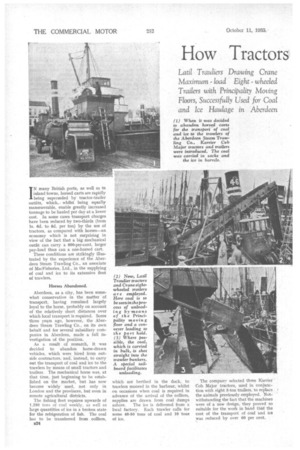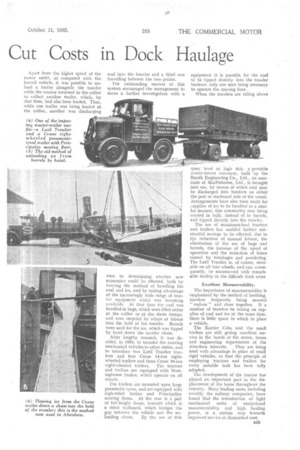How Tractors Cut Costs in Dock Haulage
Page 38

Page 39

If you've noticed an error in this article please click here to report it so we can fix it.
Lath l Trauliers Drawing Crane Maximum load Eight wheeled Trailers with Principality Moving Floors, Successfully Used for Coal and Ice Haulage in Aberdeen IN many British ports, as well as in inland towns, horsed carts are rapidly being superseded by tractor-trailer outfits, which,, whilst being equally manceuvrabIe, enable greatly increased tonnage to be hauled per day at a lower cost. In some cases transport charges have been reduced by two-thirds (from is. 6d. to ad, per ton) by the use of tractors, as compared with horses—an economy which is not surprising in view of the fact that a big mechanical outfit can carry a 600-per-cent. larger pay-load than can a one-horsed cart.
These conditions are strikingly illustrated by the experience of the Aberdeen Steam Trawling Co., an associate of MacFisheries. Ltd., in the supplying of coal and ice to its extensive fleet of trawlers.
Horses Abandoned.
Aberdeen, as a city, has been somewhat conservative in the matter of transport, having remained largely loyal to the horse, probably on account of the relatively short distances over which local transport is required. Some three years ago, however, the Aberdeen Steam Trawling Co., on its own behalf and for several subsidiary companies in Aberdeen, made a full investigation of the position.
As a result of research, it was decided to abandon horse-drawn vehicles, which were hired from outside contractors, and, instead, to carry out the transport of coal and ice to the trawlers by means of small tractors and trailers. The mechanical horse was, at that time, just beginning to be established ,on the market, but has now become widely used, not only in London and the provinces, but even in remote agricultural districts.
The fishing fleet requires upwards of 1,250 ton,, of coal weekly, as well as large quantities of ice in a broken state for the refrigeration of fish. The coal has to be transferred from colliers,
B24 which are berthed in the dock, to trawlers moored in the harbour, whilst on occasions when coal is required in advance of the arrival of the colliers, supplies are drawn from coal dumps
ashore. The ice is delivered from a local factory. Each trawler calls for some 40-50 tons of coal and 10 tons of ice.
The compan7,7 selected three 'Carrier Cob Major tractors, used in conjunction with eight 3-ton trailers, to replace the animals previously employed. Notwithstanding the fact that the machines were of a new design, they proved so suitable for the work iti hand that the cost of the transport of coal and ice was reduced by over 60 per cent. Apart from the higher speed of the motor outfit, as compared with the horsed vehicle, it was possible to unload a trailer alongside the trawler while the tractor returned to the collier to collect another trailer, which, by that time, had also been loaded. Thus, while one trailer was being loaded at the collier, another was discharging coal into the trawler and a third was travelling between the two points.
The outstanding success of , this system encouraged the management to make a further investigation with a view to determining whether new economics could be effected, both by varying the method of handling the coal and ice, and by taking advantage of the increasingly wide range of tractor equipment which was becoming available. At that time, the coal was handled in bags, which were filled either at the collier or at the shore dumps, and were emptied by relays of labour 'into the hold of the trawler. Barrels were used for the ice, which was tipped by hand down the trawler chute.
After lengthy research, it was decided, in 1934, to transfer the existing -mechanical Vehicles to other duties, and to introduce two Latil Traulier tractors and four Crane 14-ton eight • wheeled trailers and three Crane 10-ton eight-wheeled trailers. The tractors and trailers are equipped with Westinghouse brakes, which operate on all wheels,
The trailers are mounted upon large pneumatic tyres, and are equipped with high-sided bodies and Principality moving floors. At the rear is a pair of full-height doors, beneath which is a sided tailboard, which bridges the gap between the vehicle and the un loading chute. By the use of this equipment it is possible for the coal to be tipped directly into the trawler bunkers. only one man being necessary to operate the moving floor.
When the trawlers are riding above quay, level at high tide, a portable power-driven conveyer, built by the Strath Engineering Co., Ltd„ an associate of MacFiaheries, Ltd., is brought into use, by means of which coal may be discharged into bunkers on either the port or starboard side of the vessel. Arrangements have also been made for .upplies of ice -to be handled in a similar manner, this commodity now being carried in bulk, instead of in barrels, and tipped directly into the trawler.
The use of maximum-load tractors and trailers has enabled further substantial savings to be effected, due to tbe reduction of manual labour, the elimination of the use of bags and barrels, the increase of the speed of operation and the reduction of losses caused by breakages and powdering. The Latil Traulier is, of course, steerable on all four wheels, and can, consequently, he manceuvred with remarkable facility in the difficult dock areas Excellent Manceuvrability.
The importance of ma,nceuvrability is emphasized by the method of berthing, trawlers frequently being moored " end-on " and close together. If a number of trawlers be taking on supplies of coal and ice at the same time, there is little space in which to place a vehicle.
The Harrier Cobs and the small trailers are still giving excellent service in the hands of the stores, boxes and engineering departments of the Aberdeen interests. They are being used with advantage in place of small rigid vehicles, so that the principle of employing tractors and trailers for every suitable task has been fully adopted.
The development of the tractor has played an important part in the displacement of the horse throughout the country. Many leading users, including notably the railway companies, have found that the introduction of light mechanical units of exceptional marveuvrability and high hauling power, is a certain step towards improved service at diminished cost.




























































































